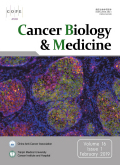- 钛学术文献服务平台 \
- 学术期刊 \
- 医药卫生期刊 \
- 肿瘤学期刊 \
- 癌症生物学与医学(英文版)期刊 \
Complement C3a activates osteoclasts by regulating the PI3K/PDK1/SGK3 pathway in patients with multiple myeloma
Complement C3a activates osteoclasts by regulating the PI3K/PDK1/SGK3 pathway in patients with multiple myeloma
基本信息来源于合作网站,原文需代理用户跳转至来源网站获取
摘要:
Objective: Myeloma bone disease (MBD) is the most common complication of multiple myeloma (MM). Our previous study showed that the serum levels of C3/C4 in MM patients were significantly positively correlated with the severity of bone disease. However, the mechanism of C3a/C4a in osteoclasts MM patients remains unclear. Methods: The formation and function of osteoclasts were analyzed after adding C3a/C4a in vitro. RNA-seq analysis was used to screen the potential pathways affecting osteoclasts, and the results were verified by Western blot, qRT-PCR, and pathway inhibitors. Results: The osteoclast area per view induced by 1 μg/mL (mean ± SD: 50.828 ± 12.984%) and 10 μg/mL (53.663 ± 12.685%) of C3a was significantly increased compared to the control group (0 μg/mL) (34.635 ± 8.916%) (P < 0.001 and P < 0.001, respectively). The relative mRNA expressions of genes, OSCAR/TRAP/RANKL/cathepsin K, induced by 1 μg/mL (median: 5.041, 3.726, 1.638, and 4.752, respectively) and 10 μg/mL (median: 5.140, 3.702, 2.250, and 5.172, respectively) of C3a was significantly increased compared to the control group (median: 3.137, 2.004, 0.573, and 2.257, respectively) (1 μg/mL P = 0.001, P = 0.003, P < 0.001, and P = 0.008, respectively; 10 μg/mL: P < 0.001, P = 0.019, P < 0.001, and P = 0.002, respectively). The absorption areas of the osteoclast resorption pits per view induced by 1 μg/mL (mean ± SD: 51.464 ± 11.983%) and 10 μg/mL (50.219 ± 12.067%) of C3a was also significantly increased (33.845 ± 8.331%) (P < 0.001 and P < 0.001, respectively) compared to the control. There was no difference between the C4a and control groups. RNA-seq analysis showed that C3a promoted the proliferation of osteoclasts using the phosphoinositide 3-kinase (PI3K) signaling pathway. The relative expressions of PIK3CA/phosphoinositide dependent kinase-1 (PDK1)/serum and glucocorticoid inducible protein kinases (SGK3) genes and PI3K/PDK1/p-SGK3 protein in the C3a group were significantly higher than in the control group. The activation role of C3a in osteoclasts of MM patients was reduced by the SGK inhibitor (EMD638683). Conclusions: C3a activated osteoclasts by regulating the PI3K/PDK1/SGK3 pathways in MM patients, which was reduced using a SGK inhibitor. Overall, our results identified potential therapeutic targets and strategies for MBD patients.

推荐文章
东北林蛙PDK1基因的克隆及生物信息学分析
东北林蛙
PDK1基因
基因克隆
生物信息学分析
PI3K 蛋白在食管鳞癌中的表达与临床意义
食管癌
PI3K
免疫组织化学
异丙酚通过激活 PI3K/Akt 信号通路抑制癌细胞转移
异丙酚
PI3K/Akt
乳腺癌
转移
18β-甘草次酸对肝癌HepG2细胞增殖及PI3K、PDK1、AKT蛋白表达的影响
肝癌
肝癌细胞
18β-甘草次酸
细胞增殖
磷脂酰肌醇-3激酶
磷脂酰肌醇依赖性蛋白激酶1
蛋白激酶B
内容分析
关键词云
关键词热度
相关文献总数
(/次)
(/年)
文献信息
| 篇名 | Complement C3a activates osteoclasts by regulating the PI3K/PDK1/SGK3 pathway in patients with multiple myeloma | ||
| 来源期刊 | 癌症生物学与医学(英文版) | 学科 | |
| 关键词 | |||
| 年,卷(期) | 2021,(3) | 所属期刊栏目 | ORIGINAL ARTICLE |
| 研究方向 | 页码范围 | 721-733 | |
| 页数 | 13页 | 分类号 | |
| 字数 | 语种 | 英文 | |
| DOI | 10.20892/j.issn.2095-3941.2020.0430 | ||
五维指标
引文网络
引文网络
二级参考文献 (38)
共引文献 (1)
参考文献 (41)
节点文献
引证文献 (0)
同被引文献 (0)
二级引证文献 (0)
1993(1)
- 参考文献(1)
- 二级参考文献(0)
1994(1)
- 参考文献(1)
- 二级参考文献(0)
1996(2)
- 参考文献(2)
- 二级参考文献(0)
1998(1)
- 参考文献(0)
- 二级参考文献(1)
1999(1)
- 参考文献(0)
- 二级参考文献(1)
2000(1)
- 参考文献(0)
- 二级参考文献(1)
2001(1)
- 参考文献(0)
- 二级参考文献(1)
2002(2)
- 参考文献(0)
- 二级参考文献(2)
2003(2)
- 参考文献(0)
- 二级参考文献(2)
2004(3)
- 参考文献(1)
- 二级参考文献(2)
2005(1)
- 参考文献(0)
- 二级参考文献(1)
2006(4)
- 参考文献(1)
- 二级参考文献(3)
2007(3)
- 参考文献(0)
- 二级参考文献(3)
2008(1)
- 参考文献(0)
- 二级参考文献(1)
2009(5)
- 参考文献(3)
- 二级参考文献(2)
2010(4)
- 参考文献(3)
- 二级参考文献(1)
2011(5)
- 参考文献(3)
- 二级参考文献(2)
2012(7)
- 参考文献(3)
- 二级参考文献(4)
2013(4)
- 参考文献(3)
- 二级参考文献(1)
2014(6)
- 参考文献(4)
- 二级参考文献(2)
2015(5)
- 参考文献(3)
- 二级参考文献(2)
2016(2)
- 参考文献(1)
- 二级参考文献(1)
2017(6)
- 参考文献(5)
- 二级参考文献(1)
2018(5)
- 参考文献(5)
- 二级参考文献(0)
2019(4)
- 参考文献(2)
- 二级参考文献(2)
2020(2)
- 参考文献(0)
- 二级参考文献(2)
2021(0)
- 参考文献(0)
- 二级参考文献(0)
- 引证文献(0)
- 二级引证文献(0)
引文网络交叉学科
相关学者/机构
期刊影响力
癌症生物学与医学(英文版)
主办单位:
中国抗癌协会
出版周期:
季刊
ISSN:
2095-3941
CN:
12-1431/R
开本:
16开
出版地:
天津市河西区体院北环湖西路天津市肿瘤医院C座综合楼三楼
邮发代号:
6-173
创刊时间:
2004
语种:
eng
出版文献量(篇)
1054
总下载数(次)
0
期刊文献
相关文献
推荐文献
- 期刊分类
- 期刊(年)
- 期刊(期)
- 期刊推荐
癌症生物学与医学(英文版)2022
癌症生物学与医学(英文版)2021
癌症生物学与医学(英文版)2020
癌症生物学与医学(英文版)2019
癌症生物学与医学(英文版)2018
癌症生物学与医学(英文版)2017
癌症生物学与医学(英文版)2016
癌症生物学与医学(英文版)2015
癌症生物学与医学(英文版)2014
癌症生物学与医学(英文版)2013
癌症生物学与医学(英文版)2012
癌症生物学与医学(英文版)2011
癌症生物学与医学(英文版)2010
癌症生物学与医学(英文版)2009
癌症生物学与医学(英文版)2008
癌症生物学与医学(英文版)2007
癌症生物学与医学(英文版)2006
癌症生物学与医学(英文版)2005

 免费查重
免费查重










